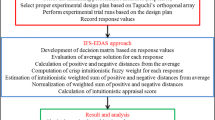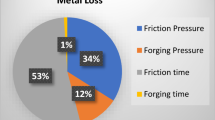Abstract
Ultrasonic machining (USM) process has several important performance measures (responses), some of which are correlated. For example, material removal rate and tool wear rate are highly correlated. Although in the recent past several methods have been proposed in the literature to resolve the multi-response optimization problems, only a few of them take care of the possible correlation between the responses. All these methods primarily make use of principal component analysis (PCA) to consider the possible correlation between the responses. Process engineers may face the difficulty of selecting the appropriate method because the relative optimization performances of these methods are unknown. In this paper, two sets of past experimental data on USM process are analysed using three methods dealing with the multiple correlated responses, and the optimization performances of these three methods are subsequently compared. It is observed that both the weighted principal component (WPC) and PCA-based TOPSIS methods result in a better optimization performance than the PCA-based grey relational analysis method. However, the WPC method is preferable because of its simpler computational procedure.
Similar content being viewed by others
References
Rozenberg LD, Kazantsev VF (1964) Ultrasonic cutting. Consultants Bureau, New York
Pandey PC, Shan HS (1981) Modern machining processes. McGraw-Hill, New Delhi
Ghosh A, Mallik AK (1985) Manufacturing science. Affiliated East West, New Delhi
Jain VK (2005) Advanced machining processes. Allied Publishers, New Delhi
Thoe TB, Aspinwall DK, Wise MLH (1998) Review on ultrasonic machining. Int J Mach Tools Manuf 38:239–255
Singh R, Khamba JS (2006) Ultrasonic machining of titanium and its alloys: a review. J Mater Process Technol 173:125–135
Dam H, Quist P, Schreiber MP (1995) Productivity, surface quality and tolerances in ultrasonic machining of ceramics. J Mater Process Technol 51:358–368
Benkirane Y, Kremer D, Moisan A (1999) Ultrasonic machining: an analytical and experimental study on contour machining based on neural network. Ann CIPR 48:135–138
Phadke MS (1989) Quality engineering using robust design. Prentice Hall, Englewood Cliffs
Singh R, Khamba JS (2007) Taguchi technique for modelling material removal rate in ultrasonic machining of titanium. Mater Sci Eng A 460–461:365–369
Dvivedi A, Kumar P (2007) Surface quality evaluation in ultrasonic drilling through the Taguchi technique. Int J Adv Manuf Tech 34:131–140
Kumar J, Khamba JS, Mohapatra SK (2009) Investigating and modelling tool-wear rate in the ultrasonic machining of titanium. Int J Adv Manuf Tech 41:1107–1117
Kumar J, Khamba JS (2010) Modeling the material removal rate in ultrasonic machining of titanium using dimensional analysis. Int J Adv Manuf Tech 48:103–119
Cong WL, Pei ZJ, Deines T, Wang QG, Treadwell C (2010) Rotary ultrasonic machining of stainless steels: empirical study of machining variables. Int J Manuf Res 5:370–386
Maghsoodloo S, Ozdemir G, Jordan V, Huang CH (2004) Strengths and limitations of Taguchi’s contributions to quality, manufacturing and process engineering. J Manuf Syst 23:73–126
Kumar J, Khamba JS, Mohapatra SK (2008) An investigation into the machining characteristics of titanium using ultrasonic machining. Int J Machining Machinability Mater 3:143–161
Liao HC (2006) Multi-response optimization using weighted principal component. Int J Adv Manuf Tech 27:720–725
Tong L-I, Wang C-H (2002) Multi-response optimization using principal component analysis and grey relational analysis. Int J Ind Eng 9:343–350
Tong L-I, Wang C-H, Chen H-C (2005) Optimization of multiple responses using principal component analysis and technique for order preference by similarity to ideal solution. Int J Adv Manuf Tech 27:407–414
Derringer G, Suich R (1980) Simultaneous optimization of several response variables. J Qual Technol 12:214–219
Castillo ED, Montgomery DC, McCarville D (1996) Modified desirability functions for multiple response optimization. J Qual Technol 28:337–345
Kim K, Lin D (2000) Simultaneous optimization of multiple responses by maximizing exponential desirability functions. J R Stat Soc C Appl Stat 43:311–325
Khuri AI, Conlon M (1981) Simultaneous optimization of multiple responses represented by polynomial regression functions. Technometrics 23:363–375
Castillo E, Montgomery DC (1993) A nonlinear programming solution to the dual response problem. J Qual Technol 25:199–204
Boyle CR, Shin WS (1996) An interactive multiple response simulation optimization method. IIE Trans 14:453–463
Pignatiello JR, Joseph J (1993) Strategies for robust multi-response quality engineering. IIE Trans 25:5–15
Tsui K (1999) Robust design optimization for multiple characteristic problems. Int J Prod Res 37:433–445
Su CT, Hsieh KL (1998) Applying neural networks to achieve robust design for dynamic quality characteristic. Int J Qual Reliab Manage 15:509–519
Hsieh KL, Tong LI (2001) Optimization of multiple quality responses involving qualitative and quantitative characteristics in IC manufacturing using neural networks. Comp Ind 46:1–12
Hsi HM, Tsai SP, Wu MC, Tzuang CK (1999) A genetic algorithm for the optimal design of microwave filters. Int J Ind Eng 6:282–288
Cheng BC, Cheng CJ, Lee ES (2002) Neuro-fuzzy and genetic algorithm in multiple response optimization. Comput Math Appl 44:1503–1514
Pasandideh SHR, Niaki STA (2006) Multi-response simulation optimization using genetic algorithm within desirability function framework. Appl Math Comput 175:366–382
Chiang TL, Su CT (2003) Optimization of TQFP modelling process using neuro-fuzzy-GA approach. Eur J Oper Res 147:156–164
Tai CY, Chen TS, Wu MC (1992) An enhanced Taguchi method for optimising SMT processes. J Electron Manuf 2:91–100
Ramakrishnan R, Karunamoorthy L (2006) Multi response optimization of wire EDM operations using robust design of experiments. Int J Adv Manuf Technol 29:105–112
Pan LK, Wang CC, Wei SL, Sher HF (2007) Optimizing multiple quality characteristics via Taguchi method-based grey analysis. J Mater Process Technol 182:107–116
Tong LI, Chen CC, Wang CH (2007) Optimization of multi-response processes using the VIKOR method. Int J Adv Manuf Tech 31:1049–1057
Montgomery DC (1984) Design and analysis of experiments. Wiley, New York
Author information
Authors and Affiliations
Corresponding author
Rights and permissions
About this article
Cite this article
Gauri, S.K., Chakravorty, R. & Chakraborty, S. Optimization of correlated multiple responses of ultrasonic machining (USM) process. Int J Adv Manuf Technol 53, 1115–1127 (2011). https://doi.org/10.1007/s00170-010-2905-y
Received:
Accepted:
Published:
Issue Date:
DOI: https://doi.org/10.1007/s00170-010-2905-y




